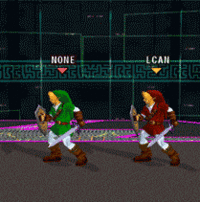L-canceling
L-canceling (an abbreviation of lag canceling or L button canceling, written on the official Super Smash Bros. website as smooth landing) is a technique in Super Smash Bros. and Super Smash Bros. Melee that allows characters to act faster than usual when landing in the middle of an aerial attack. L-cancelling is done by pressing a shield button 11 frames or fewer before landing during an aerial attack in Smash 64 (the grab button also works because of its unique properties), or by pressing the shield button 1 to 7 frames before landing in Melee.
Only regular aerial attacks can be L-cancelled; special moves that have landing lag cannot. If an attack is auto-cancelled then L-cancelling has no effect. All aerials can be cancelled except Mr. Game & Watch's nair, bair and uair.
In Super Smash Bros.
Better known as Z-cancelling as the Z button is the shield button, L-cancelling in Smash 64 is performed by pressing Z 11 or fewer frames before landing. Doing so causes the character's regular landing animation to play instead of the air attack's landing animation, reducing their lag to 4 frames. Compared to lag intervals in the 20-30 range, this can allow incredible attack speed when combined with techniques such as double jump cancelling, resulting in shield break combos.
In Super Smash Bros. Melee
L-cancelling in Melee is performed by pressing L, R or Z up to 7 frames before landing. Doing so causes the air attack's landing animation to play at double speed, cutting the lag time in half (rounded down). While not as potent as the previous game, the decrease in lag is still significant enough to make L-cancelled aerial attacks better than comparable ground attacks. This is especially true for characters with heavier aerial landing lag, most notably Bowser and Ganondorf.
In later games
L-cancelling is not present in Brawl for unclear reasons. The most common theory is that, like the removal of wavedashing, L-cancelling's removal was to shift the game's focus away from competitive depth towards casual accessibility. The lack of L-cancelling acts as an indirect nerf to characters that have aerial attacks with heavier landing lag and/or low jumps (most notably Ganondorf).
L-cancelling continues to be absent from Super Smash Bros. 4.
Notes
- It is impossible to L-cancel Mr. Game & Watch's neutral, back, and up aerials due to using a nonstandard landing lag state (as they function as special moves, which also cannot be L-cancelled), similarly to how Ness's up and down smashes act unusually.
